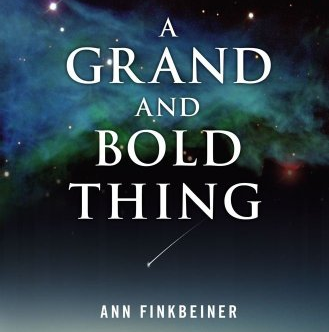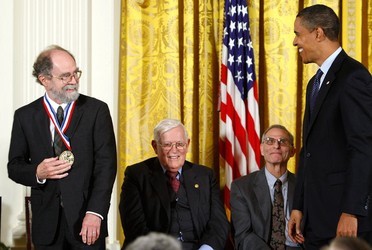The Bookmobile: An Excerpt from Ann Finkbeiner's "A Grand and Bold Thing"
by Ann Finkbeiner

Ann Finkbeiner’s A Grand and Bold Thing: An Extraordinary New Map of the Universe Ushering In A New Era of Discovery documents the founding of the Sloan Digital Sky Survey-and is out today! “Delightful,” says Publisher’s Weekly! “Totally awesome,” says The Awl! The Sloan Digital Sky Survey, begun ten years ago, is mapping 100 million celestial objects-and measuring distance between a million galaxies, giving us the first real map of where we live. And here, an excerpt!
“And what do you want to do with the new telescopes,” I asked Wallace Sargent, who’s a Caltech astronomer. “That’s a boring question,” he said, “and the answer is so boring I won’t answer it. It’s like you’re a Victorian explorer looking for the source of the Nile and when you run across the Pyramids, if you had any sense at all, you’d investigate them. Pardon the expression, but I point the fucking telescope at the sky and see what’s out there.” -interview with Wallace Sargent, 1991

The Hubble Space Telescope’s first image looked like all hell. A month later, late June of 1990, the telescope’s political shepherd, John Bahcall, found out what had gone wrong. He called some interested local astronomers-Jill Knapp, Don Schneider, and particularly Jim Gunn-and since astronomy in Princeton, NJ, usually involves food, he invited them to supper at a Route-206 strip-mall Chinese diner. He told them that NASA was about to announce that the telescope’s perfect mirror had been ground to the perfectly wrong shape. Jim Gunn, who had designed and overseen the construction of the telescope’s principal camera, had also seen the first image, and had thought the problem might be fixed. But no, now Bahcall was telling him no, it was the mirror’s shape, the telescope couldn’t focus, the problem was irrevocable.
Jim and Bahcall did most of the talking. Why hadn’t the astronomers overseeing the NASA contractors caught the mistake? It was a dumb mistake, a beginner’s textbook mistake. Nor did they think that astronauts could change out the mirror on a telescope in orbit nearly 400 miles up. Could they themselves come up with any brilliant ideas? Not at the moment. Certainly any kind of repair would take years, money, and a lot more effort, and they both had already dumped their lives and careers into it. Don Schneider, who had been Jim’s graduate student and was now working with Bahcall, sat there feeling overwhelmed. Jill Knapp, who was married to Jim, mostly listened. Dinners with Bahcall always started early, so they all went home early too….
On July 19, 1990, Jim sat down to write a letter to his community. “My view and point are very simple,” he began. “We are a discipline of technical incompetents, happy to let our or NASA’s engineers build our tools to their desires, by and large, not ours.” He began using capital letters: “It was an ASTRONOMICAL failure; it was an ASTRONOMICAL satellite”-and took a shot at NASA-”and it does not matter a whit that it was probably some fool at PE [Perkin-Elmer, the NASA contractor for the mirror] that caused it and some entirely expected failure of NASA’s criminally infantile QA program that failed to catch it.” Then he took dead aim at the astronomers-”Not that there would have been enough technically competent people in the field to have taken the two G$ and done anything with it.” He concluded: “You may certainly circulate this letter if you wish.”
The letter was electronic and it was printed out and taped to office doors, forwarded and posted to electronic bulletin boards, and talked about in the halls of astronomy departments everywhere. Afterward Jim decided to cut bait; he gave up his privileges to use the telescope. “I was just terribly, terribly disheartened,” he said. He didn’t think it had a chance in hell of being fixed anyway.
NASA, of course, pulled off an ingenious fix, installed by astronauts dangling improbably over the telescope up in space. The Hubble Space Telescope went on to find the two numbers and took gorgeously sharp pictures of everything else: of tiny, distant, golden galaxies and nearby electric blue whirlpools, of radiant towers of starbirth and the opalescent mists of their deaths. An upgraded version of Jim’s camera took some of the best of them.
Jim regretted having cut bait, but only a little. He had just come up with another idea for another camera, even better than Hubble’s with bigger CCDs. He’d put the camera on an unassuming telescope on the ground, turn it on, and let the night sky roll over it. It would make the first-ever three-dimensional, digital sky survey.
The survey would have a million galaxies in it. With a million galaxies, you could make a map showing where galaxies lived, and whether they lived around other galaxies, and whether little chains of galaxies were actually parts of a larger network, and whether that network was actually a network of networks, and how big it all got. With a million galaxies you could make a true census: how galaxies differed, how baby galaxies changed as they grew, and what kinds of galaxies they grew into. With a million galaxies you could watch the universe growing up.
Jim thought a million-galaxy survey was intellectually huge and personally irresistible, the most complete map of the universe ever. It could live in computers and be accessible at all hours to all comers for all time. It could start a new kind of astronomy.
Above: Jim Gunn receiving the National Medal of Science in October, 2009, for “the crucial role those technological marvels played in the creation of the Sloan Digital Sky Survey, which has cataloged 200 million stars, galaxies, and quasars; discovered the most distant known quasars; and probed the epoch of formation of the first stars and galaxies.”
Ann Finkbeiner is a proprietor of The Last Word on Nothing, where they are talking about parasitic wasps today, and the author of A Grand and Bold Thing: An Extraordinary New Map of the Universe Ushering In A New Era of Discovery, which is out today. She runs the graduate program in science writing at Johns Hopkins in The Writing Seminars.
